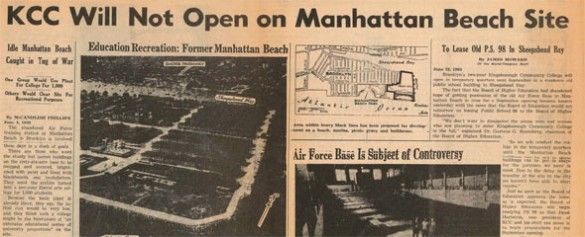KCC Historical Newspaper Shows Development Of School And Communities

Sheepshead Bites reader Stan Kaplan recently passed along a copy of the May 10, 1973, edition of Scepter, the student newspaper of Kingsborough Community College. Its yellowed pages commemorated the 10th anniversary of the school’s establishment, illustrating the complex story of Manhattan Beach, Sheepshead Bay and the higher education institution through original materials, reprinted news articles and historical advertisements. Headlines like “KCC Will Not Open on Manhattan Beach Site” remind us that the school has always played a tug-of-war with the community in which it exists, and the reporting reminds us that journalism, indeed, is only history’s first draft – and quite a rough one at that.
With permission from Kingsborough Community College, Sheepshead Bites brings you a digital version of the newspaper in full, with an introduction from former Brooklyn Historian John Manbeck, who also served as faculty adviser to the paper at the time of publication.
Back in 1969, I became the faculty adviser to Kingsborough’s student newspaper, Scepter. Fortunately, the publication had a very astute student staff who challenged creativity. As a student voice of a new community college created only eight years earlier, the staff sought out ideas that would stimulate publication and draw in readers from the college and its surrounding community, Manhattan Beach.
So the students explored the history of the community and unearthed the fascinating past of the peninsula, complete with original articles from the press and graphics. This collection of material became the nucleus of the Kingsborough Historical Society, a study of the southern shore of Brooklyn.

In order to publicize the society, which had its opening exhibit advertised in the right-hand box next to the flag, two students from the newspaper, Gail Smollon and John Rossi, gathered and laid out original articles in a broadsheet format. (Scepter had been a tabloid layout.) This gave more room to include material and advertisements. They attempted to simulate a 19th Century publication, which traditionally featured commercial notices on the front page.
The scope of the publication included articles about Coney Island, Brighton Beach and Sheepshead Bay as well as Manhattan Beach. The newspaper content follows a chronological order with articles in the front half about 19th Century Coney Island and the two great hotels on Manhattan Beach that accommodated the crowds from the Sheepshead Bay race track. After the three Brooklyn race tracks closed in 1910, the second phase of Manhattan Beach’s history unfolded when Joseph Day, a real estate auctioneer, purchased the land so developers could construct a bungalow community.
An ancillary aspect of this elaborate and carefully controlled community—lots were a prescribed size, utility lines were buried, service vehicles delivered through alleys behind the houses—was the Manhattan Beach Baths constructed along the L-shaped land that ran south and east of the peninsula. Day also constructed Brighton Beach Baths that ran next to Coney Island Avenue.

With the enthusiastic assistance of Herman Field, a Manhattan Beach resident and former official photographer for Joseph Day, the historical society and the newspaper acquired priceless original photographs of the 1930s heyday at Manhattan Beach, when celebrities appeared followed by public throngs. Television, a new medium, came to Manhattan Beach to record the festivities. Field also supplied copies of the house publication of the baths, which featured ads with Milton Berle and other stars.
The third phase occurred with the outbreak of World War II, when Day sold the land to the federal government for creation of a new Coast Guard base next to a Merchant Marine training station. The Merchant Marines was a civilian arm of the Coast Guard that sailed commercial ships to Europe and Asia. After the war, the federal land lay dormant while authorities determined its fate. In the interim it was used for veterans’ housing, an Air Force base, Coast Guard housing and a veterans’ hospital.
With the encouragement of Herman Field and the president of Brooklyn College, Brooklyn’s borough president pushed for a new community college on 64 acres of the eastern tip. The southern shore had been claimed by Parks Commissioner Robert Moses for a public beach. The federal government agreed that New York City could buy the land for $1 as long as it was used for a public cause such as a college or a hospital. In 1963, City University agreed to purchase it for a new Kingsborough Community College. While the buildings were being constructed, the school would have two affiliate units, one on West End Avenue in Manhattan Beach and one on Greene Avenue in Clinton Hill.
These stages were surrounded by controversy which is recounted in newspaper articles on the last pages of the historical issue of Scepter. In 1964, the college accepted its first students in a 19th Century public school building in Sheepshead Bay. The following year, the college moved to its new quarters in the former military base. By the 1970s, plans for the future campus were presented and construction commenced.
This issue of the school paper stands as a tribute to the college as well as a history of the community. The archives of the Kingsborough Historical Society have been preserved in Brooklyn College’s Library Archives and is available for research and perusal.
John B. Manbeck has written seven books on Brooklyn and contributed to numerous others. He was appointed Brooklyn Borough Historian in 1993 by Borough President Howards Golden and served until 2002. At Kingsborough Community College, he taught English and Journalism for 32 years. He has held several city and state appointed positions and still serves on a number of advisory and foundation boards. In 1999, he was named one of the Centennial Historians of New York City. His website is www.johnbmanbeck.net.
// <![CDATA[ (function() { var scribd = document.createElement("script"); scribd.type = "text/javascript"; scribd.async = true; scribd.src = "http://www.scribd.com/javascripts/embed_code/inject.js"; var s = document.getElementsByTagName("script")[0]; s.parentNode.insertBefore(scribd, s); })(); // ]]>




